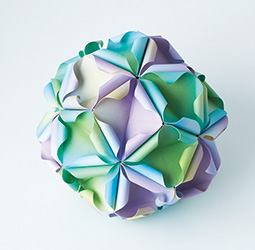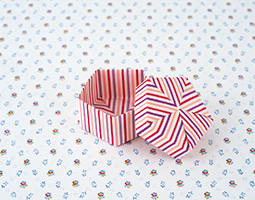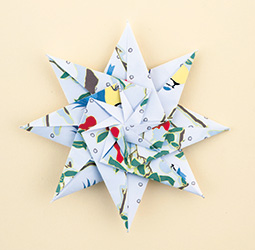INDEX
- English
- 日本語

Unit origami kusudama balls designed by Fuse Tomoko - English
- 日本語

Fuse’s large-scale installation Rock Garden Takagari by Infinite Folding Origami, exhibited at the Japan Alps Art Festival 2017

Fuse Tomoko 
A unit origami kusudama ball by Fuse 
An origami box by Fuse 
Galaxy of Stars by Fuse
December 2021
The Leading Expert in Unit Origami

“Unit origami” is a style of origami in which individual “units” are folded from single sheets of paper, then assembled to create one finished form. In this article, we introduce the creative work of Fuse Tomoko, an origami artist who has popularized unit origami around the world.

Traditionally, origami is based on folding of a single sheet of paper to create a variety of forms. Unit origami, on the other hand, assembles a number of similar origami forms called units, each made from a single sheet of paper, to create one finished form. Fuse Tomoko is at the forefront of the unit origami world. Although Fuse was not the first to discover unit origami, she has produced many original works and authored over one hundred books, popularizing unit origami around the world. Some of her books have been translated into other languages such as English, German, Italian, Korean and Chinese.

One of Fuse’s most celebrated unit origami works is based on the motif of the kusudama, a traditional Japanese decorative ball. The kusudama is created by making a set of units from a square or rectangular sheet of paper, which are then assembled into a single form without using glue. Most works are made from 12 or 30 units. In her published guide to making kusudama, Fuse explains that a piece made from 30 units takes at least five hours to create, requiring a great deal of persistence. So spectacular is the finished work, however, that it is hard to believe it is made from paper alone. Kusudama vary greatly in their appearance depending on a range of factors, including the size and color of the paper, the shape of the units, and the number of units assembled, so the scope of ideas is endless.

“When I first got into unit origami, I was able to put myself forward as an artist because there was no one else trying to take it seriously and delve deeper into that world. That was really lucky. Back then, however, many people thought that origami was about creating a piece of work from a single sheet of paper. Unit origami uses many parts, so some people said it wasn’t origami,” says Fuse.
She goes on, “Japan is said to be the home of origami, and with paper for origami readily available at stationery stores and convenience stores, people have many opportunities to become familiar with origami from a young age. That’s why people have a fixed idea of what origami is, and can't easily forget it. On the other hand, people overseas who are less familiar with origami have no preconceptions and judge works on their own merits, saying ‘this is art.’”
Fuse’s driving force is the limitless fun of origami. Even now, more than sixty years after her fascination with origami took hold, she says that its appeal has not waned.

“In the case of unit origami, the success or otherwise of a work becomes apparent only when the work is completed. It’s a really lovely moment when all the units are assembled and the work is complete, like placing the last piece of a jigsaw puzzle! Sometimes, patterns appear on the finished surface that even I didn’t expect to see. When that happens, it’s like a gift from the god of origami. As an artist, my work is about wanting to discover new forms and ways of folding, and to share that joy with as many people as I can.”
Having created many works and authored many books, since entering her 60s Fuse has taken on the new challenge of creating unprecedentedly large-scale installations. Her first such work, Rock Garden Takagari by Infinite Folding Origami, was shown at the Japan Alps Art Festival 2017 in a building on the summit of Mount Takagari in Omachi City, Nagano Prefecture, the area where Fuse resides. The “infinite folding” referred to in the title of the work is a method of folding that repeats the same folding pattern with a single sheet of paper over and over again. On seeing the geometric cones and spheres created by infinite folding, a German visitor commented that it looked like a Japanese rock garden (karesansui), and Fuse later gave the work that name.

Fuse’s passion for origami is itself like an infinite fold, continuing with no end in sight. Though she has been making origami for more than 60 years, Fuse is as enthusiastic about her craft as ever.

